|
|
|
Sort Order |
|
|
|
Items / Page
|
|
|
|
|
|
|
| Srl | Item |
| 1 |
ID:
077199
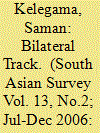

|
|
|
|
|
| Publication |
2006.
|
| Summary/Abstract |
The India-Sri Lanka Free Trade Agreement (ISLFTA) shows how bilateral cooperation can lead the way for regional cooperation. In operation, it has led to the rapid growth and diversification of Sri Lanka's exports to and imports from India. India's investment in Sri Lanka has also increased; India is now the second largest investor in Sri Lanka; and service sector cooperation has followed the growth of trade and investment. There were problems along the way but they were resolved. Moreover, this economic cooperation has overshadowed whatever political problems there were in the past. Now a Comprehensive Economic Partnership Agreement is expected to come into operation by the end of December 2006. The ISLFTA dispels the myth that economic cooperation between a large and small country benefits only the large country. Dormant complementarities can be invigorated through a bilateral free trade agreement, and new comparative advantages can be discovered, further stimulating trade.
|
|
|
|
|
|
|
|
|
|
|
|
|
|
|
|
| 2 |
ID:
077200


|
|
|
|
|
| Publication |
2006.
|
| Summary/Abstract |
The world today is characterised by unprecedented interdependence. Prosperity and poverty co-exist, while peace, justice and security are absent. Globalisation has accelerated economic and other kinds of integration, while multilateralism is a positive factor, especially for the smaller and medium states. Regional cooperation is needed both for maximising security and stability and for economic and social development. The Association of Southeast Asian Nations (ASEAN) is a good example which has expanded its cooperation with neighbouring regions and countries. Myanmar's foreign policy is based on the principles of enhancing the nation's security, bolstering economic prosperity and promoting a more peaceful and equitable world order. It concentrates on integrating with countries in the region and promoting closer links with all its neighbours. At the international level it cooperates in the eradication of narcotics
|
|
|
|
|
|
|
|
|
|
|
|
|
|
|
|
| 3 |
ID:
077195
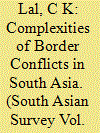

|
|
|
|
|
| Publication |
2006.
|
| Summary/Abstract |
In South Asia, boundaries are blurred but borders are bona fide. Boundaries have been blurred since geological time and so it has been culturally in the most recent times. Borders are of many kinds: between rival ethnic groups; between a majority and a minority; between different religious affiliations; or between citizens and denizens. Caste and class are there too, as is the difference between savage and cultured and others like the rural-urban dichotomy, all of which are prominent in South Asia. The commons-air, water, land-give rise to claim and counter-claim; and the political borders defy reason. It is, finally, in the mind of man that the geo-cultural unity of South Asia has to be constructed.
|
|
|
|
|
|
|
|
|
|
|
|
|
|
|
|
| 4 |
ID:
077198


|
|
|
|
|
| Publication |
2006.
|
| Summary/Abstract |
The end of the Cold War facilitated the expansion of the Association of Southeast Asian Nations (ASEAN) to include Cambodia, Laos, Myanmar and Vietnam (CLMV), all with lower economic standards than the original six members. Within this expanded framework, sub-regions have been formed, among them the Greater Mekong Sub-region (GMS), followed by a Cambodia-Laos-Vietnam Development Triangle and now by the Ayeyawadi-Chao Praya-Mekong Economic Cooperation Strategy (ACMECS). The latter was initiated by Thai Premier Thaksin Shinawatra. The Bagan declaration of 2003 sets out its aims. External partners are there and now this forum resembles a mini-ASEAN, with the detailed programmes and schedules of meetings that it has. But the promotion of ACMECS also enriches Thaksin's business empire, while there is some hint here of Sino-Japanese rivalry. In a globalised world, ACMECS cannot afford to be a closed group and it will not be long before India is invited to join
|
|
|
|
|
|
|
|
|
|
|
|
|
|
|
|
| 5 |
ID:
077192


|
|
|
|
|
| Publication |
2006.
|
| Summary/Abstract |
In South Asia, the political and the economic remained juxtaposed because of the existing disputes, particularly Kashmir. There have been many confidence-building measures (CBMs) between India and Pakistan, but tensions continue because of Kashmir. In October 2004 President Musharraf suggested a formula to start a debate on the options, to look at Kashmir as seven regions and identify them, but the Indian response was negative. There were positive developments like the start of a Srinagar-Muzaffarabad bus service and the possibility of a gas pipeline from Iran to India across Pakistan. There were other steps like the updating of the visa agreement; the visit of the APHC leadership to the other side of the LoC, which highlighted the need to involve the Kashmiris in any future settlement. The October 2005 earthquake also led to a further opening of the LoC. Track II meetings have led to increased understanding, the airing of feasible alternatives and suggestions for CBMs; back channel diplomacy has been very useful in the India-Pakistan context
|
|
|
|
|
|
|
|
|
|
|
|
|
|
|
|
| 6 |
ID:
077196


|
|
|
|
|
| Publication |
2007.
|
| Summary/Abstract |
South Asian cooperation continues to stagnate, in contrast to other regions. In terms of economic cooperation, information flows, value systems and ideas of security the differences are more in evidence than the similarities, and it is the political gulf that needs to be bridged. The spirit of regional cooperation has to be developed through a conceptual vision of a new region. But enlargement is not likely to be of help. The reconstruction of the South Asian state is the prime need of the region. Democracy has to be genuinely participatory; the intra-state regional balance is an essential component of this; and the structure and functions of government need to be addressed. South Asian states have to find a common roadmap leading to cooperation and friendship. For each state the legitimacy of power is the paramount guide in this regard
|
|
|
|
|
|
|
|
|
|
|
|
|
|
|
|
| 7 |
ID:
077197
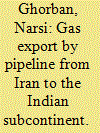

|
|
|
|
|
| Publication |
2007.
|
| Summary/Abstract |
There are huge reserves of gas in India's neighbouring region, about 42 per cent of the world's total. Gas is a fuel of advantage with a large demand in India. In Iran, one group believes gas should be exported while the other believes that gas should be used only for Iran's own needs. Alternative routes for the gas export pipeline have been studied in the past but government involvement has always led to delays. Now, however, rapid economic growth in India has led to an increased need for energy. Regional companies are increasingly capable so that there is no need to look outside the region for a task like this, and a lot of funds are available in the Gulf waiting to be invested in a project like this. Proper laws and regulations have to be adopted, and innovative financing will be needed. The pipeline will bring economic integration, will create jobs and promote trust between India and Pakistan
|
|
|
|
|
|
|
|
|
|
|
|
|
|
|
|
| 8 |
ID:
077193
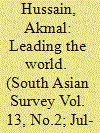

|
|
|
|
|
| Publication |
2006.
|
| Summary/Abstract |
South Asia has the possibility of leading the world in addressing the global challenges of poverty, peace and environmental degradation, and in the development of human civilisation in the twenty-first century. In order to do this, the rich cultural traditions of the societies of the region have to be brought to bear on these challenges. This includes, inter alia, the re-placement of competition by cooperation, a new relationship between human beings, nature and economic growth, the valuation of the human rather than the material, the satisfaction of need not greed. Specifically, the citizens of each country should be allowed to travel freely to every other country; a South Asia Health Foundation (SAHF) and one for education should be instituted; private sector joint venture infrastructure projects should be facilitated; and growth must be restructured for rapid poverty reduction. In short, if South Asia is to play a leadership role in the world that is taking shape now, specific initiatives must be undertaken and governments must move out of the mindset of the past
|
|
|
|
|
|
|
|
|
|
|
|
|
|
|
|
| 9 |
ID:
077194
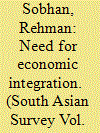

|
|
|
|
|
| Publication |
2006.
|
| Summary/Abstract |
South Asia inherited a shared identity, a shared infrastructure and institutions of governance, which were fractured by politics. There are now new opportunities that point to the possibility and necessity of reclaiming some of that inheritance. India's economy is now large enough to be welcomed by the various groupings in Asia as partner; while Asia is going to be, or already is, the new global growth centre. So South Asia must integrate in order to be part of this new dynamism, integrate its capital markets, its labour markets, its transport and other infrastructure, and take advantage of the new emerging opportunities for cooperation with West Asia, Southeast Asia and East Asia
|
|
|
|
|
|
|
|
|
|
|
|
|
|
|
|
| 10 |
ID:
077203


|
|
|
|
|
| Publication |
2007.
|
| Summary/Abstract |
This article examines briefly the major stumbling blocks in the progress of the South Asian Association for Regional Cooperation (SAARC) as a regional grouping, and then goes on to focus on three contentious issues that persist between India and Bangladesh, each of them with implications for human security. The first is ethnic divides and trans-border insurgencies, in which India is a factor. The second is the water issue between India and Bangladesh, not just arising from Farakka, but also from the Tipaimukh hydroelectric project in Assam. The third concerns the border and includes questions of trafficking in women and drugs and arms. It concludes that the region has to get out of the trap by cultivating a South Asian mind
|
|
|
|
|
|
|
|
|
|
|
|
|
|
|
|
| 11 |
ID:
077191


|
|
|
|
|
| Publication |
2006.
|
| Summary/Abstract |
Regional cooperation worldwide has not only succeeded, but also is irreversible. It is a part of globalisation, though there are limits beyond which it cannot go. So, there is a general acceptance of the present state system that disputes will not ordinarily be settled by force, that borders will not be changed, and commitment to greater integration will increase. In South Asia, regional cooperation has been a non-starter and is confined to summits and declarations. But public demand for cooperation and an expansion of contacts is growing. In response, the smaller neighbours of India do not want to open up while India itself has followed a negative policy. Relations with Bhutan and the Maldives, and now increasingly Sri Lanka, are exceptions. Even in terms of India-Pakistan relations, which are on a different plane, there are promising developments.
|
|
|
|
|
|
|
|
|
|
|
|
|
|
|
|
| 12 |
ID:
077201


|
|
|
|
|
| Publication |
2006.
|
| Summary/Abstract |
In the last decade, India has shown a keen interest in the formation of sub-regional groupings such as Bay of Bengal Initiative for Multi-Sectoral Technical and Economic Cooperation (BIMSTEC) and the Mekong Ganga Project (MGC). There are five reasons for this: the need to find a working alternative to a non-functional South Asian Association for Regional Cooperation (SAARC), the importance of this contiguous region with regard to geopolitics and security, rivalry with China, the growing economic links between India and the Association of Southeast Asian Nations (ASEAN) and the strategic advantages of enhanced relations with Myanmar. There are barriers to regional integration within the region mentioned, such as weak political institutions and human rights violations, but ASEAN offers a good model. India needs to adopt a multi-dimensional consultative approach in this matter.
|
|
|
|
|
|
|
|
|
|
|
|
|
|
|
|
| 13 |
ID:
077202
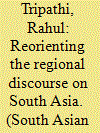

|
|
|
|
|
| Publication |
2006.
|
| Summary/Abstract |
The recent discourse on regionalism in South Asia has been marked more with the problems that hinder regional cooperation rather than the prospects that the grouping has in shaping the collective future of the region. Given the faltering steps the South Asian Association for Regional Cooperation (SAARC) has taken at regionalism in the last two decades, such pessimism is perhaps justified. As an institution, SAARC has remained an intergovernmental mechanism, which has had little relevance for the people of South Asia. The association has allowed the political logic to dominate over the economic, and therefore lags far behind several other regional and multilateral initiatives. The article revisits the existing regional discourse in South Asia and offers an alternative approach to the regional idea, the thrust for which comes from people below rather than the states at the top. According to this alternative paradigm, states must merely act as facilitators rather than initiators of regional initiatives and build upon evolving interactions in South Asia based on knowledge, technology, commerce and culture. This would require a reinterpretation of the operative mechanism of SAARC by modifying its original mandate and procedures. Secondly it would need greater accommodation and acceptance of each other's concerns by all South Asian countries and an approach that looks beyond the traditional notions of dominance and dependence.
|
|
|
|
|
|
|
|
|
|
|
|
|
|
|
|
|
|
|
|
|